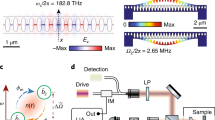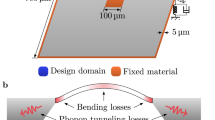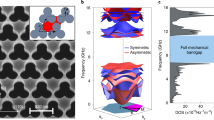Abstract
Nanoelectromechanical systems (NEMS) that operate in the megahertz (MHz) regime allow energy transducibility between different physical domains. For example, they convert optical or electrical signals into mechanical motions and vice versa1. This coupling of different physical quantities leads to frequency-tunable NEMS resonators via electromechanical non-linearities2,3,4. NEMS platforms with single- or low-degrees of freedom have been employed to demonstrate quantum-like effects, such as mode cooling5, mechanically induced transparency5, Rabi oscillation6,7, two-mode squeezing8 and phonon lasing9. Periodic arrays of NEMS resonators with architected unit cells enable fundamental studies of lattice-based solid-state phenomena, such as bandgaps10,11, energy transport10,11,12, non-linear dynamics and localization13,14, and topological properties15, directly transferrable to on-chip devices. Here we describe one-dimensional, non-linear, nanoelectromechanical lattices (NEML) with active control of the frequency band dispersion in the radio-frequency domain (10–30 MHz). The design of our systems is inspired by NEMS-based phonon waveguides10,11 and includes the voltage-induced frequency tuning of the individual resonators2,3,4. Our NEMLs consist of a periodic arrangement of mechanically coupled, free-standing nanomembranes with circular clamped boundaries. This design forms a flexural phononic crystal with a well-defined bandgap, 1.8 MHz wide. The application of a d.c. gate voltage creates voltage-dependent on-site potentials, which can significantly shift the frequency bands of the device. Additionally, a dynamic modulation of the voltage triggers non-linear effects, which induce the formation of a phononic bandgap in the acoustic branch, analogous to Peierls transition in condensed matter16. The gating approach employed here makes the devices more compact than recently proposed systems, whose tunability mostly relies on materials’ compliance17,18 and mechanical non-linearities19,20,21,22.
This is a preview of subscription content, access via your institution
Access options
Access Nature and 54 other Nature Portfolio journals
Get Nature+, our best-value online-access subscription
$29.99 / 30 days
cancel any time
Subscribe to this journal
Receive 12 print issues and online access
$259.00 per year
only $21.58 per issue
Buy this article
- Purchase on Springer Link
- Instant access to full article PDF
Prices may be subject to local taxes which are calculated during checkout




Similar content being viewed by others
Data availability
The data that support the findings of this study are available from the corresponding author upon reasonable request.
References
Craighead, H. G. Nanoelectromechanical systems. Science 290, 1532–1535 (2000).
Chen, C. et al. Performance of monolayer graphene nanomechanical resonators with electrical readout. Nat. Nanotech. 4, 861–867 (2009).
Chen, C. et al. Graphene mechanical oscillators with tunable frequency. Nat. Nanotech. 8, 923–927 (2013).
Bagci, T. et al. Optical detection of radio waves through a nanomechanical transducer. Nature 507, 81–85 (2014).
Mahboob, I., Nishiguchi, K., Okamoto, H. & Yamaguchi, H. Phonon-cavity electromechanics. Nat. Phys. 8, 387–392 (2012).
Okamoto, H. et al. Coherent phonon manipulation in coupled mechanical resonators. Nat. Phys. 9, 480–484 (2013).
Faust, T., Rieger, J., Seitner, M. J., Kotthaus, J. P. & Weig, E. M. Coherent control of a classical nanomechanical two-level system. Nat. Phys. 9, 485–488 (2013).
Mahboob, I., Okamoto, H., Onomitsu, K. & Yamaguchi, H. Two-mode thermal-noise squeezing in an electromechanical resonator. Phys. Rev. Lett. 113, 167203 (2014).
Mahboob, I., Nishiguchi, K., Fujiwara, A. & Yamaguchi, H. Phonon lasing in an electromechanical resonator. Phys. Rev. Lett. 110, 127202 (2013).
Hatanaka, D., Mahboob, I., Onomitsud, K. & Yamaguchi, H. Phonon waveguides for electromechanical circuits. Nat. Nanotech. 9, 520–524 (2014).
Hatanaka, D., Dodel, A., Mahboob, I., Onomitsud, K. & Yamaguchi, H. Phonon propagation dynamics in band-engineered one-dimensional phononic crystal waveguides. New J. Phys. 17, 113032 (2015).
Yu, S. et al. Surface phononic graphene. Nat. Mater. 15, 1243–1247 (2016).
Sato, M. et al. Observation of locked intrinsic localized vibrational modes in a micromechanical oscillator array. Phys. Rev. Lett. 90, 044102 (2003).
Sato, M., Hubbard, B. E. & Sievers, A. J. Colloquium: Nonlinear energy localization and its manipulation in micromechanical oscillator arrays. Rev. Mod. Phys. 78, 137–157 (2006).
Cha, J., Kim, K. W. & Daraio, C. Experimental realization of on-chip topological nanoelectromechanical metamaterials. Preprint at https://arXiv.org/abs/1806.10680 (2018)
Gruener, G. The dynamics of charge-density waves. Rev. Mod. Phys. 60, 1129 (1988).
Babaee, S., Viard, N., Wang, P., Fang, N. X. & Bertoldi, K. Harnessing deformation to switch on and off the propagation of sound. Adv. Mater. 28, 1631–1635 (2016).
Wang, P., Casadei, F., Shan, S., Weaver, J. C. & Bertoldi, K. Harnessing buckling to design tunable locally resonant acoustic metamaterials. Phys. Rev. Lett. 113, 014301 (2014).
Boechler, N., Yang, J., Theocharis, G., Kevrekidis, P. G. & Daraio, C. Tunable vibrational band gaps in one-dimensional diatomic granular crystal with three-particle unit cells. J. Apply. Phys. 109, 074906 (2011).
Spadoni, A. & Daraio, C. Generation and control of sound bullets with a nonlinear acoustic lens. Proc. Natl Acad. Sci. USA 107, 7230–7234 (2010).
Lydon, J., Serra-Garcia, M. & Daraio, C. Local to extended transitions of resonant defect modes. Phys. Rev. Lett. 113, 185503 (2014).
Bilal, O. R., Foehr, A. & Daraio, C. Reprogrammable phononic metasurfaces. Adv. Mater. 29, 1700628 (2017).
Seitner, M. J., Gajo, K. & Weig, E. M. Damping of metallized bilayer nanomechanical resonators at room temperature. Appl. Phys. Lett. 105, 213101 (2014).
Sounas, D. L. & Alu, A. Non-reciprocal photonics based on time modulation. Nat. Photon. 11, 774–783 (2017).
Bachelard, N. et al. Emergence of an enslaved phononic bandgap in a non-equilibrium pseudo-crystal. Nat. Mater. 16, 808–813 (2017).
Eichler, A., Moser, J., Dykman, M. I. & Bachtold, A. Symmetry breaking in a mechanical resonator made from a carbon nanotube. Nat. Commun. 4, 2843 (2013).
Biswas, T. S. et al. Remote sensing in hybridized arrays of nanostrings. Nano. Lett. 14, 2541–2545 (2014).
Kharrat, C. et al. Modal control of mechanically coupled NEMS arrays for tunable RF filters. IEEE Trans. Ultrason. Ferroelectr. Freq. Control 57, 1285–1295 (2010).
Olsson, R. H. III & El-Kady, I. Microfabricated phononic crystal devices and applications. Meas. Sci. Technol. 20, 012002 (2009).
Tsaturyan, Y., Barg, A., Polzik, E. S. & Schliesser, A. Ultracoherent nanomechanical resonators via soft clamping and dissipation dilution. Nat. Nanotech. 12, 776–783 (2017).
Vermersch, B., Guimond, P.-O., Pichler, H. & Zoller, P. Quantum state transfer via noisy photonic and phononic waveguides. Phys. Rev. Lett. 118, 133601 (2017).
Lee, S. et al. Graphene metallization of high-stress silicon nitride resonators for electrical integration. Nano. Lett. 13, 4275–4279 (2013).
Acknowledgements
We acknowledge partial support for this project from NSF EFRI Award no. 1741565, Binnig and Rohrer Nanotechnology Center at IBM Zurich and the Kavli Nanoscience Institute at Caltech. We thank E. Togan at ETH Zurich for his advice on interferometers.
Author information
Authors and Affiliations
Contributions
J.C. and C.D. conceived the idea for the research. J.C. designed and fabricated the samples. J.C. built the experimental set-ups and performed the experiments. J.C. developed the analytical models and performed the numerical simulations. J.C. and C.D. analysed the data and wrote the manuscript.
Corresponding author
Ethics declarations
Competing interests
The authors declare no competing interests.
Additional information
Publisher’s note: Springer Nature remains neutral with regard to jurisdictional claims in published maps and institutional affiliations.
Electronic supplementary material
Supplementary Information
Supplementary Figures 1–13
Rights and permissions
About this article
Cite this article
Cha, J., Daraio, C. Electrical tuning of elastic wave propagation in nanomechanical lattices at MHz frequencies. Nature Nanotech 13, 1016–1020 (2018). https://doi.org/10.1038/s41565-018-0252-6
Received:
Accepted:
Published:
Issue Date:
DOI: https://doi.org/10.1038/s41565-018-0252-6
This article is cited by
-
Validating an algebraic approach to characterizing resonator networks
Scientific Reports (2024)
-
Robust boundary-induced bulk propagations in elastic waveguides with nonplanar surfaces
Science China Physics, Mechanics & Astronomy (2024)
-
Nanoelectromechanical resonators for gigahertz frequency control based on hafnia–zirconia–alumina superlattices
Nature Electronics (2023)
-
Mechanically-tunable bandgap closing in 2D graphene phononic crystals
npj 2D Materials and Applications (2023)
-
Acoustic resonances in non-Hermitian open systems
Nature Reviews Physics (2023)



